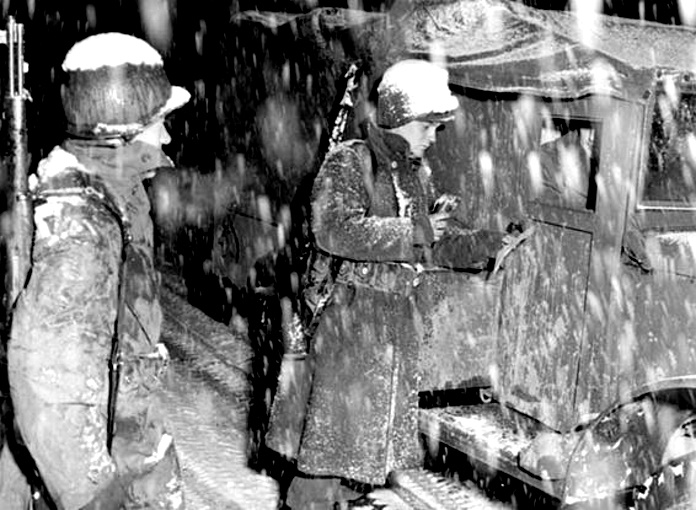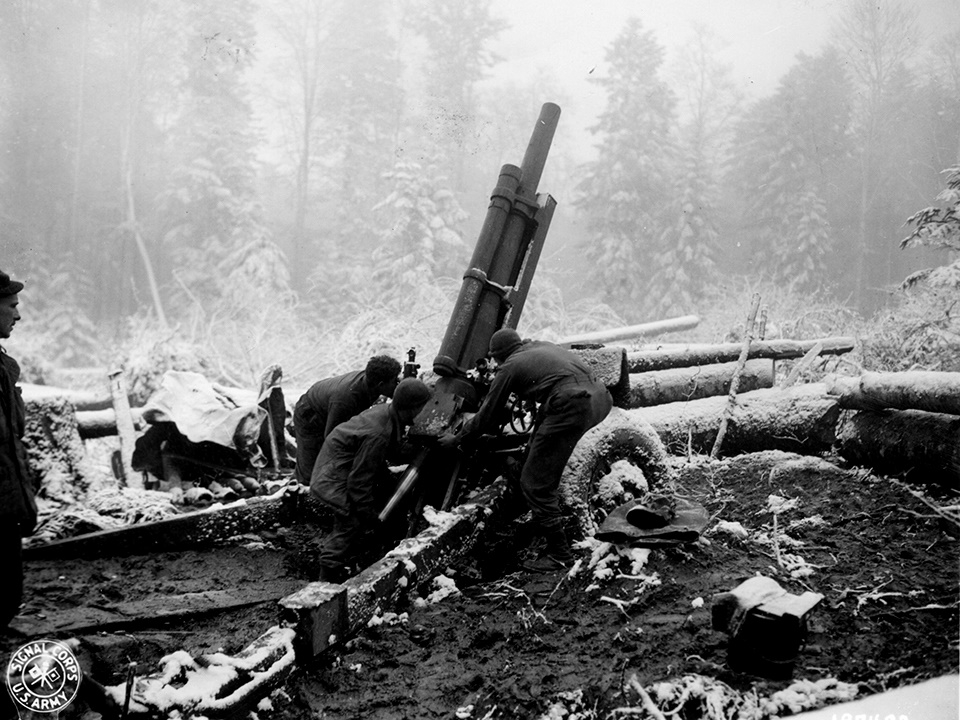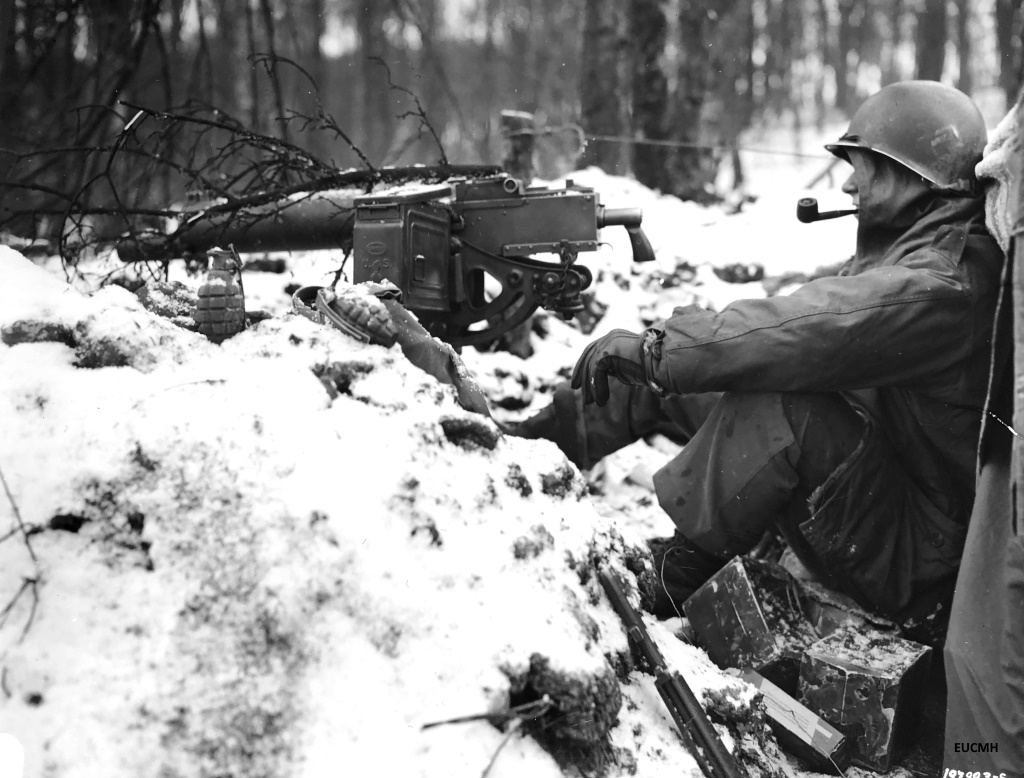At 1800 in the evening, Able Co CO met Gen Robert D. Hasbrouck, CG of the 7-AD near the two remaining bridges. The General said that he believed all of his troops had withdrawn, but that he was not sure. He told the company commander to withhold blowing the bridges until midnight in order to take care of any isolated groups which might still be on the other side. Since this conflicted with his orders, the Able Co CO contacted the Battalion and got permission to have the time changed to 2400.
Almost simultaneously, the company commander received a call from the 1st platoon leader that the Battalion on the right had withdrawn from the positions they had been occupying. The commander went over to contact this Battalion and found it in positions a good 500 yards behind the river line. The Battalion commander explained that he wanted grazing fire for his weapons and that this position furnished him with the best possible. It is true, that he did have approximately 400 yards of grazing fire, but about 100 yards of the western bank were in complete defilade, thus leaving Able Co with an exposed flank. Able Co’s mission was te keep the enemy from crossing the Salm, not to get grazing fire. After a short, and futile argument, the commander of Able Co saw that a higher authority was needed to get any changes made. He went back to his own Battalion command post and notified his Battalion commander of the situation. The Regiment was immediately notified, and the 3rd Battalion or the 112-IR (28-ID) was ordered to move back into their original positions (*Personal Knowledge). Just at this time, firing was heard from the 2nd platoon’s outpost across the river. Consequently the 3rd Battalion, 112-IR never did move forward again, and for the next forty-eight hours, Able Co was operating with an exposed flank.
While the company commander of Able Co had been trying to straighten out this problem, the outposts had been on the alert. At approximately 2200, one of them saw a column of men approaching. The outpost was not sure whether or not they were Americans. When, at a distance of about ten yards, the column proved to be Germans, the outpost opened fire on them at point-blank range. He did not stop to count the casualties but did know that the Germans were in confusion. The platoon leader immediately gave the predetermined signal for the other outposts to withdraw and started checking them back across the bridges. Some of the outposts were a little slow returning. By the time the last man was crossing the bridge, the Germans had recovered from their confusion, and were almost to the edge of the river, firing across it. As the platoon leader crossed the bridge, he gave another blast on his whistle; the arranged signal for the demolition men to do their job. He then took cover behind the railroad bank. When nothing happened, he looked for and found the demolition men who had not been in a position when the action began, and was afterward unable to reach it.
It was then realized that a foolish, and probably costly mistake had been made in preparing the bridges for demolition. No consideration had been given to the possibility of blowing them from cover. Instead, thirty-second fuzes were located at the bridges themselves. The Germans now were on the very edge of the river, and some had even crossed it (*Statements Lt Lamm, Sgt Preztos, Sgt Clement 26/12). The company commander ordered the platoon leader to get the bridges blown somehow. He, in turn, got his eight outposts together and ordered them to rush back across the bridge followed by the demolition men. On signal, the fuze lighters were to be pulled. The men were to get back to the railroad bank undercover. This plan, hasty as it was, succeeded, chiefly because the Germans did not expect such a sudden show of aggressiveness; or rather it succeeded in part because only the railroad bridge was destroyed. The fuze lighter for the road bridge failed to work (*Statement Lt Lamm 26/12). Regiment and Battalion called down to the company demanding a reason for the delay, as emphatic orders had been given to blow the bridges at all costs.
All the while the German strength was building up. What had originally been estimated as a platoon, assumed the strength of a company; probably a recon unit. The fire of six machine guns could be heard, and a tank came up, and almost approached the abutments of the now defunct railroad bridge, from where it systematically fired at the houses just across the river (*Lt Lamm 26/12). It was apparent that it would now take more than the fire of the eight men from the 2nd platoon to drive the Germans back. The 1st and 3rd platoons were ordered to fire at the maximum rate, if possible at the flash of the enemy’s guns. This concentrated burst caused the Germans to take cover, so enabling a small force from the 2nd platoon to again cross the bridge, while the demolition personnel attached another fuze light. Using the same tactics as before, the covering force once more withdrew on the signal. This time the fuze exploded, but the demolitions again failed to do so. Meanwhile, the 3rd platoon was having trouble with a few Germans who had crossed the bridge on the initial assault and were now entrenched behind some of the houses on the western bank of the stream. Several men of the platoon went and eliminated them.
The Field Artillery forward observer was in the 3rd platoon area attempting to call for fire on the opposite bank. However, this was ineffective, and most of the rounds were lost in the darkness of the night (*Capt Comb).
Finally, men of the 2nd platoon secured a box of Composition C-2 and placed it in the center of the bridge. They exploded it by firing a HE bazooka round into it. This blew up the bridge except for several stringers, which were easily destroyed. Immediately, peace settled down in the area, and, except for brief spasmodic bursts of rifle fire, the enemy made no further moves. All during the night though, vehicles and tanks could be heard coming up into position. Early next morning, the Germans could be heard moving weed in a lumberyard along the river, about three or four hundred yards to the north of Vielsalm. There was no doubt in the minds of the men of Able Co, that the Germans were securing this in preparation for a river crossing, but they were unable to do anything, because of the complete failure of the artillery to register. At about 0400, a German plane flew overhead taking photographs. A few minutes later, Able Co was alerted by the Battalion, who warned them that Fallschirmjägers were dropping in the area (Maj Milam 02/21/48). Much to the disappointment of the men, these turned out to be dummies.
THE WITHDRAWAL
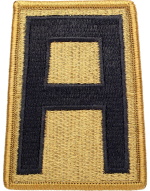
 Dawn of December 24, broke clear for the first time since the 82-A/B Division had arrived in Belgium. As has previously been explained, some of Able Co’s positions were completely out in the open. However, because of the excellent fortifications built, only one man was wounded, and this happened when he needlessly exposed himself. In the meantime, an important decision was made at the US 1-A’s Headquarters. The 82-A/B had accomplished its mission of covering the
Dawn of December 24, broke clear for the first time since the 82-A/B Division had arrived in Belgium. As has previously been explained, some of Able Co’s positions were completely out in the open. However, because of the excellent fortifications built, only one man was wounded, and this happened when he needlessly exposed himself. In the meantime, an important decision was made at the US 1-A’s Headquarters. The 82-A/B had accomplished its mission of covering the 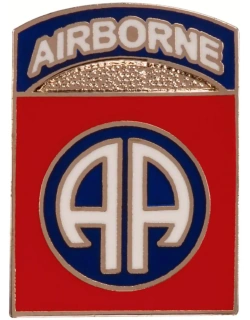
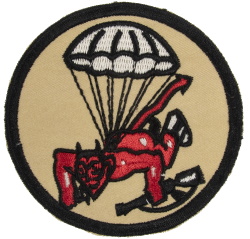 withdrawal of the 7-AD. This left the 82-A/B in a dangerously extended salient with a frontage of 18 miles. Furthermore, it was known that the Germans were planning an attack on them with the 2.SS-Panzer-Division, the 9.SS-Panzer-Division, and the 62.Volksgrenadier-Divisionnd. The Division commander was therefore ordered to withdraw to the Trois Ponts – Erria – Manhay line (*82-A/B Report). Extracts of Field Order #4, Hqs 508-PIR, concerning this read as follows: At H hour on D night, 82nd Division withdraws to sew defensive position covering force will consist of one rifle platoon per company. 1345, December 24, 1944).
withdrawal of the 7-AD. This left the 82-A/B in a dangerously extended salient with a frontage of 18 miles. Furthermore, it was known that the Germans were planning an attack on them with the 2.SS-Panzer-Division, the 9.SS-Panzer-Division, and the 62.Volksgrenadier-Divisionnd. The Division commander was therefore ordered to withdraw to the Trois Ponts – Erria – Manhay line (*82-A/B Report). Extracts of Field Order #4, Hqs 508-PIR, concerning this read as follows: At H hour on D night, 82nd Division withdraws to sew defensive position covering force will consist of one rifle platoon per company. 1345, December 24, 1944).
At 1500, the 1st Battalion was alerted for the withdrawal. The Battalion commander, Company commanders, and Battalion staff made a rapid recon of the route and the new defensive positions, ten miles to the rear. Before leaving on this survey, the Able Co commander gave brief instructions to be carried out during his absence. He selected the 2nd platoon as the covering force to stay behind. They were picked, because, being in reserve, they could cover the other platoons in case the Germans attacked while the withdrawal was in progress. Orders were given that all heavy equipment, such as blanket rolls and extra ammunition would be sent to the rear, where it would be picked up by the Battalion S-4 (*Personal Knowledge). Specific orders were then given that each man individually, would have the reasons for the withdrawal explained to him. The Battalion commanders had told all company commanders that both the Regimental and Division commanders were greatly concerned with the attitude of the troops toward the withdrawal. This was the first time in the combat history of the Division, that it or any of its units had to execute such a maneuver. They feared that the Germans’ use of American arms and uniforms might cause great confusion in such a withdrawal.
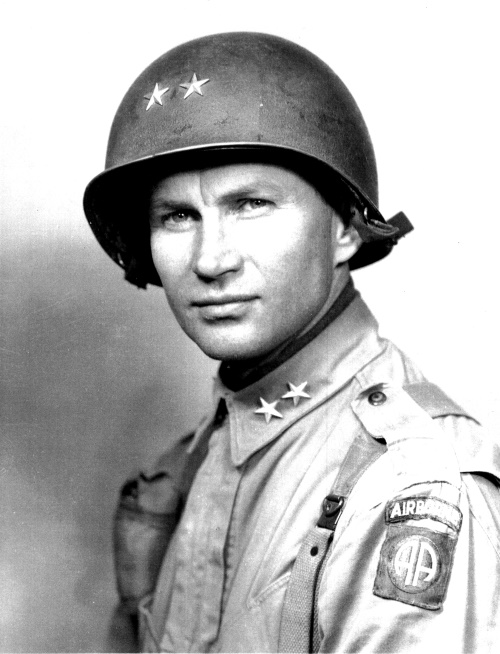 These fears were unfounded, and later Gen Gavin was to say: I have never seen a better-executed operation than the withdrawal on Christmas Eve. The troops willingly and promptly carried into execution all the withdrawal plans, although they openly and frankly criticized them, and failed to understand the necessity for it. But everybody pitched in, and the withdrawal went smoothly.
These fears were unfounded, and later Gen Gavin was to say: I have never seen a better-executed operation than the withdrawal on Christmas Eve. The troops willingly and promptly carried into execution all the withdrawal plans, although they openly and frankly criticized them, and failed to understand the necessity for it. But everybody pitched in, and the withdrawal went smoothly.
When the company commander returned from his recon, his instructions had been carried out. In addition, the 2nd platoon leader had received his orders from the Battalion executive officer, who was commanding the Battalion covering force. In 2000, the withdrawal started. Able Co’s progressed very slowly. Because of the bright moonlight and their exposed positions, it was necessary for them to go back one by one to a previously designated company assembly area in Rencheux. In spite of these difficulties, the company, with the exception of the 2nd Platoon, had withdrawn completely by 2115 and were marching to the rear with the rest of the Battalion. The Germans gave no indication that they were aware of any movement. The march ten miles back to the new defensive positions was uninterrupted, except for a ten-minute break at midnight. Everyone was thinking about past and happier Christmases, but all kept their thoughts to themselves. Upon reaching the new positions, work was immediately started on digging in.
Meanwhile, at Rencheux, the 2nd platoon placed skeleton forces in the 1st and 3rd platoon positions as these withdrew. They then settled down to the long vigil until 0300, when they too would withdraw. The only contact they had with the commander of the covering force was by messenger. All the mortars of the Battalion had been withdrawn with the main body, and the only supporting fire that could be counted on was from the ineffective artillery.
Around 2200, the sound of German vehicles and voices could be heard across the river. Judging by the hammering noises, it appeared that they were preparing a span of bridging. Word of this was sent back to the Battalion command post, and an attempt was made to get an artillery concentration. The artillery liaison officer’s radio would not work, so the Battalion Executive officer sent him back to the rear in disgust (*Maj B.F. Delanater 27/12/48). At 2340, the Germans launched a full-scale attack. One of the heaviest artillery barrages yet sustained by the 2nd platoon fell on them and the town of Rencheux. A few minutes later a smoke screen started to drift over. Two tanks edged up to the river bank and began returning the fire of the 2nd platoon. By 0045, the Germans started crossing the river. The 2nd platoon was prevented from using their maximum fire by the Germans’ artillery and tanks, but nevertheless, inflicted many casualties. The platoon leader sent a runner back to the battalion to orient them to the situation.
Twenty minutes elapsed without a word from Battalion. The Germans were progressing foot by foot up the main road into Rencheux. The platoon leader realized that he could not hold out much longer. He, therefore, sent the assistant platoon leader back to the Battalion, requesting permission to withdraw. The assistant platoon leader arrived at the command post, where he gave a distorted report that the platoon was withdrawing. The Battalion executive officer, knowing the platoon leader from previous combat, felt, however, that he would never withdraw without an order. He, therefore, sent a runner back to him with orders to withdraw. He sent the assistant platoon leader to the Battalion area, but he never reached this as he was captured. The messenger never reached the 2nd platoon either.
Meanwhile, the platoon leader waited. He soon realized that there was only one thing left to do, and that was to withdraw. The Germans had completely split his platoon and were coming up the road in force. His men, who had been flanking the road were casualties or had retreated. The remainder were silent, and no firing could be heard from the other company areas either. He, therefore, gave the order for his troops on the right of the road to withdraw, while he himself crossed it, collecting all the men he could find. He had already left the town of Rencheux and joined up with the remainder of his platoon when he heard a machine gun open fire back in his old area. Immediately he realized that this was the gun crew who had been buried by a shell burst early in the fight. Apparently, they had dug themselves out and put their gun back into action. The platoon leader went back into the town as far as he could, calling for these men at the top of his voice. He waited and soon the chatter of the US .30 stopped, and two soldiers appeared, carrying a gun, tripod, and two boxes of ammunition (*AAR 1/508 Jan 10, 1945).
The 2nd platoon of Able Co was unable to get to the Battalion assembly area but continued cross country back to the new defensive positions. They lost ten men in this action, but, in conjunction with the covering force of the rest of the Battalion, had withdrawn in the face of what was estimated as a battalion plus of Germans, and had held them up for two hours.
ANALYSIS AND CRITICISM
In analyzing this operation, two things, in particular, stand out. The first of these is the failure of the demolitions on the night of December 23. When the bridges were prepared, it was not taken into account that they might be under fire at the time they were to be blown. This was a grave error from both the technical and tactical points of view. The solution would have been the use of a longer fuze, which should have been placed in such a position that it could be fired from the cover. In fact, two sets of fuzes should have been laid as an added precaution, to take care of the possibility of a misfire, such as did happen. But for the aggressive action of the 2nd platoon, the bridges might have been captured intact by the Germans.
The second point was the inability of the artillery to render any support, on the nights of December 23 and 24. It is easy to criticize this thoughtlessly, but an explanation is in order. Prior to the German attack on the night of the 23rd, the artillery had been unable to register any of their fires. This was because of the presence of friendly troops throughout their range, and because it is almost impossible to adjust artillery fire at night, particularly in hilly terrain, without prior registration. Another point was the failure of the artillery communications on the night of the withdrawal. This was inexcusable, and merely bears out part of the old sayings Artillery must be able to march, shoot, and communicate.
No mention has been made of the use of the company’s 60-MM mortars. They were not used to very good advantage, and at no time played an important part in this action. There are several reasons for this, and the same faults had been present in other companies, and in other campaigns. Under the then-current table of organization of a parachute infantry regiment, the mortar squad was an integral part of each platoon. However, since a 60-MM mortar used singly, is not very effective, they were placed in the battery during the action covered by this monograph. Unfortunately, this method was not much more successful because of the lack of centralized control, and of the different standards of training of each squad. Furthermore, a parachute company did not have any transportation. Therefore the only 60-MM mortar ammunition available was that which the men carried. Frequently there was no re-supply. Companies were consequently prone to use their mortars only in cases of extreme emergency.
The withdrawal itself was excellent, and there is little to criticize about it, though it was a mistake to rely on messenger service only within the covering force of the Battalion. Even if there were no spare radios available to leave behind, the platoon should at least have been given some telephones.
LESSONS LEARNED
1. In an emergency, airborne units can be used efficiently and effectively as regular Infantry.
2. Parachute units should be organized as closely as possible along the lines of corresponding ground units.
3. If artillery defensive fires are to be effective, they must be previously registered.
4. Effective liaison is necessary for the proper functioning of the Artillery-Infantry team.
5. Troops properly dug in can withstand a vast amount of artillery fire.
6. Morale is an important factor in any combat operation, but it is especially so in a retrograde movement.
7. Adequate communication is necessary for success in combat.
Major Jonathan E. Adams Jr
Able Co, 1/508-PIR, 82-A/B
Commanding












